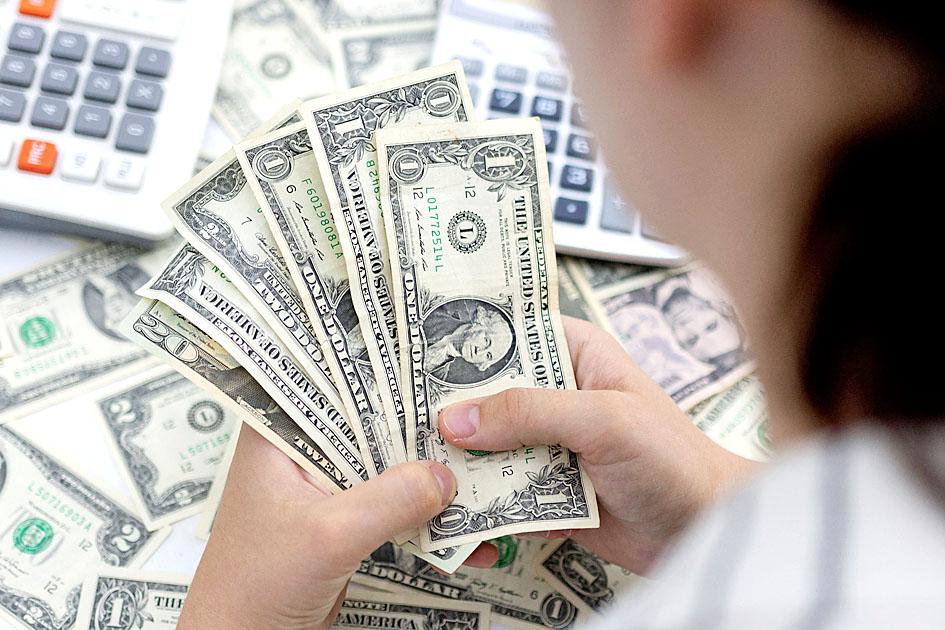Asian currencies fell yesterday, highlighting the pressure wrought by a stronger US dollar as the US Federal Reserve races ahead with interest rate hikes.
The New Taiwan dollar declined against the US dollar, dropping NT$0.075 to close at NT$29.790 — an almost one-month low.
The Indian rupee declined to a record low of 78.29 rupees per US dollar, while the Philippine peso dropped as much as 0.7 percent to 54.635 pesos, its weakest level since November 2005.

Photo: Reuters
The South Korean won slid to a 13-year low of 1,297.85 won versus the greenback.
In Hong Kong, the monetary authority has bought HK$78.1 billion (US$10 billion) of the local dollar so far this month, including its HK$20.8 billion purchase on Tuesday. The currency still continues to linger near the weak end of its HK$7.75 to HK$7.85 trading band against the greenback.
Regional currencies have been caught out by the Fed’s hawkish bias, which stands in contrast to the more patient policy stance adopted by Asian central banks. Idiosyncratic factors such as a widening current-account deficit for the Philippines and geopolitical risks for South Korea are adding to the pressure.
“Central bank rate signals are becoming a bigger driver of Asian currencies,” said Eugenia Victorino, head of Asia strategy at Skandinaviska Enskilda Banken AB in Singapore. “Downward pressure on currencies where central banks are behind the curve in managing inflation will increase, particularly as the Fed keeps hiking aggressively.”
Fed Chairman Jerome Powell was scheduled to deliver his semi-annual testimony on monetary policy to the US Congress yesterday and today.
He has said that another 75 or 50 basis-point hike was likely at the next review next month.
It is not just developing Asian currencies that are feeling the heat. The Japanese yen yesterday tumbled to a fresh 24-year low of ¥136.71 per US dollar, as the Bank of Japan’s ultra-loose policy contrasts with the Fed’s hawkish bias.
“Ongoing global growth concerns, inflation worries and fears of tighter financial conditions continue to keep a leash on risk appetite,” Malayan Banking Bhd FX strategist Christopher Wong (黃經隆) said. “Those Asian ex-Japan central banks perceived to be behind the curve could further be marginalized, for instance TWD [NT dollar] and THB [Thai baht].”
Incoming Bangko Sentral ng Pilipinas governor Felipe Medalla yesterday said that the Philippine monetary authority is unlikely to raise its key rate by more than 25 basis points today.
“Most likely not,” Medalla said in a mobile phone message, when asked if a bigger rate increase is needed due to the peso’s drop.
“Of course I don’t know for sure how MBMs will vote,” he added, referring to Monetary Board members.
Jonathan Ravelas, chief market strategist at BDO Unibank Inc in Manila, said the peso might fall to a fresh record low if the Philippines opts for gradual rate hikes while the Fed tightens aggressively.
Some other policymakers are more inclined to wait. Indonesia’s central bank does not need to rush to raise interest rates unless it sees fundamental inflationary pressures, Governor Perry Warjiyo said.
Similarly, Thailand has refrained from raising borrowing costs and opted instead to cap prices of essential goods to contain inflation.
Additional reporting by staff writer

The US dollar was trading at NT$29.7 at 10am today on the Taipei Foreign Exchange, as the New Taiwan dollar gained NT$1.364 from the previous close last week. The NT dollar continued to rise today, after surging 3.07 percent on Friday. After opening at NT$30.91, the NT dollar gained more than NT$1 in just 15 minutes, briefly passing the NT$30 mark. Before the US Department of the Treasury's semi-annual currency report came out, expectations that the NT dollar would keep rising were already building. The NT dollar on Friday closed at NT$31.064, up by NT$0.953 — a 3.07 percent single-day gain. Today,

‘SHORT TERM’: The local currency would likely remain strong in the near term, driven by anticipated US trade pressure, capital inflows and expectations of a US Fed rate cut The US dollar is expected to fall below NT$30 in the near term, as traders anticipate increased pressure from Washington for Taiwan to allow the New Taiwan dollar to appreciate, Cathay United Bank (國泰世華銀行) chief economist Lin Chi-chao (林啟超) said. Following a sharp drop in the greenback against the NT dollar on Friday, Lin told the Central News Agency that the local currency is likely to remain strong in the short term, driven in part by market psychology surrounding anticipated US policy pressure. On Friday, the US dollar fell NT$0.953, or 3.07 percent, closing at NT$31.064 — its lowest level since Jan.

The New Taiwan dollar and Taiwanese stocks surged on signs that trade tensions between the world’s top two economies might start easing and as US tech earnings boosted the outlook of the nation’s semiconductor exports. The NT dollar strengthened as much as 3.8 percent versus the US dollar to 30.815, the biggest intraday gain since January 2011, closing at NT$31.064. The benchmark TAIEX jumped 2.73 percent to outperform the region’s equity gauges. Outlook for global trade improved after China said it is assessing possible trade talks with the US, providing a boost for the nation’s currency and shares. As the NT dollar

The Financial Supervisory Commission (FSC) yesterday met with some of the nation’s largest insurance companies as a skyrocketing New Taiwan dollar piles pressure on their hundreds of billions of dollars in US bond investments. The commission has asked some life insurance firms, among the biggest Asian holders of US debt, to discuss how the rapidly strengthening NT dollar has impacted their operations, people familiar with the matter said. The meeting took place as the NT dollar jumped as much as 5 percent yesterday, its biggest intraday gain in more than three decades. The local currency surged as exporters rushed to